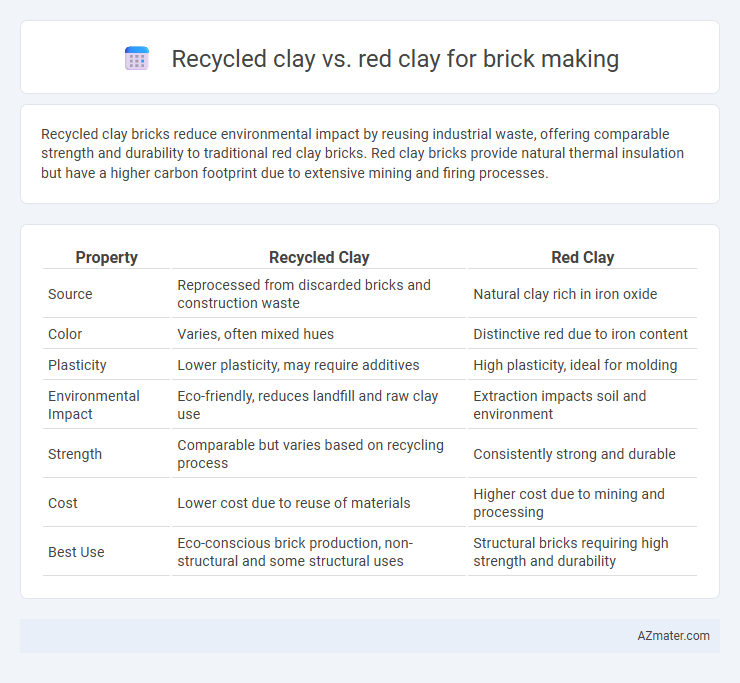Recycled clay bricks reduce environmental impact by reusing industrial waste, offering comparable strength and durability to traditional red clay bricks. Red clay bricks provide natural thermal insulation but have a higher carbon footprint due to extensive mining and firing processes.
Table of Comparison
| Property | Recycled Clay | Red Clay |
|---|---|---|
| Source | Reprocessed from discarded bricks and construction waste | Natural clay rich in iron oxide |
| Color | Varies, often mixed hues | Distinctive red due to iron content |
| Plasticity | Lower plasticity, may require additives | High plasticity, ideal for molding |
| Environmental Impact | Eco-friendly, reduces landfill and raw clay use | Extraction impacts soil and environment |
| Strength | Comparable but varies based on recycling process | Consistently strong and durable |
| Cost | Lower cost due to reuse of materials | Higher cost due to mining and processing |
| Best Use | Eco-conscious brick production, non-structural and some structural uses | Structural bricks requiring high strength and durability |
Introduction to Brick Making Materials
Recycled clay offers an eco-friendly alternative in brick making by utilizing waste materials, reducing landfill impact and conserving natural resources compared to traditional red clay. Red clay, rich in iron oxide, provides strong binding properties and durability, making it a preferred material in conventional brick production. The choice between recycled clay and red clay influences the environmental footprint, mechanical strength, and thermal properties of the finished bricks.
What Is Recycled Clay?
Recycled clay refers to clay material that has been reclaimed and processed from previously used bricks or construction debris, making it an eco-friendly alternative to traditional raw clay. Compared to red clay, which is naturally occurring and rich in iron oxide giving bricks their characteristic color and strength, recycled clay helps reduce environmental impact by minimizing waste and conserving natural resources. While red clay offers consistent plasticity and durability for brick making, recycled clay may require additional processing to ensure uniform quality and performance in construction applications.
Overview of Red Clay Properties
Red clay, a natural material rich in iron oxide, imparts a distinctive reddish hue and high plasticity, making it ideal for brick making. Its fine particle size ensures excellent moldability and uniform drying, while its thermal properties contribute to strong, durable bricks with good insulation capabilities. Recycled clay may vary in composition and consistency, but red clay's consistent chemical and physical characteristics provide reliable quality and performance in brick manufacturing.
Environmental Impact: Recycled Clay vs Red Clay
Recycled clay bricks significantly reduce environmental impact by minimizing the need for raw material extraction and decreasing landfill waste, promoting sustainable construction practices. Red clay bricks require intensive mining processes that lead to habitat destruction, soil erosion, and increased carbon emissions due to energy consumption during firing. Utilizing recycled clay lowers carbon footprints and conserves natural resources, making it an eco-friendlier alternative in brick manufacturing.
Cost Comparison: Recycled Clay and Red Clay
Recycled clay bricks typically offer a cost advantage over traditional red clay bricks due to lower raw material expenses and reduced energy consumption in processing. Red clay bricks often incur higher costs related to extensive mining, transportation, and kiln firing required to achieve desired strength and durability. While recycled clay bricks may have slightly higher initial processing costs for collection and preparation, long-term savings from waste minimization and decreased environmental impact contribute to overall cost efficiency.
Brick Strength and Durability Analysis
Recycled clay bricks exhibit enhanced compressive strength due to the densification process during re-firing, which improves particle bonding compared to traditional red clay bricks. The incorporation of recycled clay reduces porosity, resulting in higher durability and resistance to weathering and mechanical wear. Red clay bricks, while widely used, tend to have lower strength and durability metrics due to their natural porosity and susceptibility to moisture absorption.
Aesthetic Differences in Finished Bricks
Recycled clay bricks often display a varied, rustic texture with subtle color inconsistencies due to the mix of materials, enhancing their unique aesthetic appeal. In contrast, red clay bricks are prized for their consistent deep reddish hue and smooth surface, providing a classic, uniform appearance favored in traditional construction. The slight imperfections in recycled clay bricks contribute to a handcrafted look, while red clay bricks maintain a polished, predictable finish ideal for modern architectural designs.
Sustainability and Eco-Friendliness
Recycled clay bricks significantly reduce environmental impact by reusing materials and minimizing the need for virgin clay extraction, thereby conserving natural resources and lowering landfill waste. Red clay bricks, while traditional and durable, often require extensive mining and high-energy kiln firing, contributing to habitat disruption and carbon emissions. Utilizing recycled clay promotes circular economy practices in construction and enhances sustainability by reducing raw material consumption and waste generation.
Industrial Applications and Suitability
Recycled clay offers enhanced sustainability and cost efficiency in industrial brick manufacturing by reducing raw material consumption and waste. Red clay remains the preferred material for traditional brick making due to its high plasticity, durability, and excellent firing properties that suit structural applications. Industrial suitability of recycled clay depends on its purity and processing, whereas red clay's consistent mineral composition ensures reliable performance in load-bearing construction.
Future Trends in Brick Making Materials
Recycled clay bricks are gaining traction due to their eco-friendly benefits, reducing waste and conserving natural resources compared to traditional red clay bricks. Innovations in blending recycled clay with other sustainable materials enhance durability and thermal efficiency, aligning with increasing environmental regulations and green building certifications. Future trends in brick making emphasize circular economy principles, promoting the reuse of industrial by-products while maintaining the structural integrity and aesthetic appeal of red clay bricks.

Infographic: Recycled clay vs Red clay for Brick making
 azmater.com
azmater.com